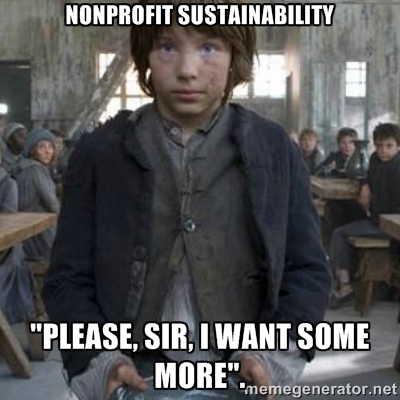 A while ago I wrote about self-care, and how we should all try to find time to do the things that make us happy. For me, one of those things is mixing drinks. It makes me happy to discover or invent new cocktails. Here are several that are inspired by people and concepts in nonprofit work. I also asked friends on NWB’s Facebook page to send in their own recipes, and those are listed at the end. Please submit your own inspired creations in the comment section.
A while ago I wrote about self-care, and how we should all try to find time to do the things that make us happy. For me, one of those things is mixing drinks. It makes me happy to discover or invent new cocktails. Here are several that are inspired by people and concepts in nonprofit work. I also asked friends on NWB’s Facebook page to send in their own recipes, and those are listed at the end. Please submit your own inspired creations in the comment section.
The Executive Director
1 oz vodka
2 oz grapefruit juice
2 oz passionfruit juice
1 more oz vodka
Another oz vodka
Put ice into glass or mug. Pour everything else in and stir. Garnish with more vodka. Drink at either 9am or 9pm at the office. Strong, and slightly bitter.
The Retreat
1½ oz coffee liqueur
1½ oz brandy
1 oz nighttime cold and flu medicine
2 Tylenol Extra Strength tablet
Pour coffee liqueur, brandy, and cold and flu medicine into glass without ice. Drop in Tylenol tablets. Drink the cocktail slowly while discreetly checking emails on your smartphone.
The LOI
1/6 oz dry gin
1/6 oz Kirsch
1/6 oz orange Curaçao
1/6 oz dry vermouth
1/6 oz sweet vermouth
Strip of lemon peel.
Mix all ingredients together with ice and strain into a shot glass. Garnish with lemon peel strip. Give it to someone. If they like it, make them another, but instead of using 1/6 oz for each ingredient, use 1 full oz, but change orange Curaçao to blue Curaçao and Kirsch into blackberry brandy.
The Strategic Plan
½ oz blue Curaçao
1 tsp raspberry syrup
¼ oz maraschino liqueur
¼ oz yellow Chartreuse
¼ oz Cointreau
Chill everything for several hours, including a shot glass. Slowly and carefully pour the liqueurs in the order listed over the back of a teaspoon into shotglass. Do not stir. When done correctly, you will have a colorful, multi-layered drink that is not only delicious, but beautiful to look at. Do not drink it. Show it to everyone, then put it in the fridge and then throw it out after a year or two.
The Annual Event
1 piece edible gold leaf
2 oz Cinzano extra dry vermouth
½ oz framboise
½ oz black Sambuca
½ oz pureed sardines
rose petal, lime wedge, lemon peel twist, raspberry, pineapple piece, candied hibiscus, black truffle shaving, cape gooseberry
Put gold leaf into glass. Shake Cinzano, framboise, and Sambuca with ice and pour into glass. Float pureed sardines on top. Garnish with rose petal, lime wedge, lemon peel twist, raspberry, pineapple piece, hibiscus, truffle shaving, and cape gooseberry. Drink up, rest for three months, then start gathering ingredients to make another one.
The Earnest Volunteer
Contributed by Krystyna Williamson
1/2 ounce dark rum
Jamaican ginger ale
1/2 tsp lime juice
mint leaves
1 1/2 ounce simple syrup
Muddle the mint in the syrup, add the rest and stir gently. Comes in on fire, heads off in three directions, and never really gets the job done.
The Corporate Foundation Administrator:
Contributed by J. Eric Smith
2 parts Jagermeister
1 part Mayonnaise
1 part Worcestershire Sauce
1 part Cottage Cheese
Mix ingredients, shake vigorously, and drink very, very, VERY slowly, smiling all the while. If you gag or frown, you do not get the grant. Ever.
The College Intern
Contributed by Claire Petersky
1 1/2 oz vodka
3/4 oz peach schnapps
1/2 oz creme de cassis
2 oz orange juice
2 oz cranberry juice
1/4 cup white sugar
Orange slice and maraschino cherry for garnish
Very sweet, has some power – but you don’t want more than two of them.
The Development Director:
Contributed by Sharonne Navas
1 ½ oz Bailey’s Irish Cream
1 ½ oz Butterscotch Schnapps
¾ oz Goldschlager
1 tbsp 151 Rum
1 dash Cinnamon
Mix all ingredients with ice in a shaker and pour into glass. If your Development Director has gotten the organization to fundraising goal by mid-year, you can light this drink on fire. If the Director hasn’t, you can light him/her on fire.* Win-Win!!
The [Certain Grantor]’s Website
Contributed by Claire Petersky
5 cherries
Angostura bitters
Lemonhart 151 rum
3 oz gin
1 bar spoon rosewater
½ oz lime juice
Place cherries in your mixing glass, add sugar. Place equal portions of Angostura bitters and Lemonhart 151 rum into an oil mister/sprayer. Mist the Angostura mixture through a flame. Flame until sugar caramelizes. Fill with ice and add gin, rosewater, and lime juice. Then, because the cocktail has timed out, throw the entire concoction down the disposal. Take a bottle of sriracha and splash a drop in your eye. Beat head against your kitchen countertop. Repeat from the beginning, at least three times.
***
(*Note, Nonprofit with Balls does not condone the setting of anyone on fire, even Development Directors who haven’t met outcomes).
***
Make Mondays suck a little less. Get a notice each Monday morning when a new post arrives. Subscribe to NWB by scrolling to the top right of this page and enter in your email address.








